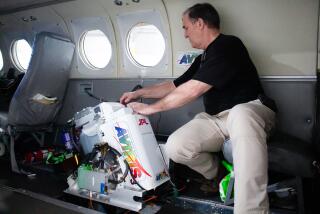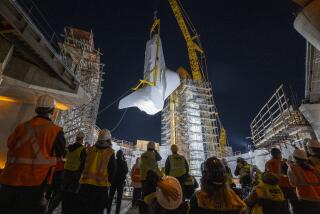Shuttle Lifts Off to Survey Earth Sites With Radar
KENNEDY SPACE CENTER, Fla. — Space shuttle Endeavour’s astronauts rocketed into orbit and switched on a powerful radar instrument Friday to help scientists save vanishing animal species and look for lost civilizations under the desert sands.
The crew of six lifted off at sunrise on a mission that was delayed 1 1/2 months because of a last-second engine shutdown on the launch pad.
NASA plans to survey nearly 600 sites with the $366-million radar, including the Silk Road traveled by Marco Polo 700 years ago and the area in Rwanda where Dian Fossey worked to save Africa’s imperiled mountain gorillas.
Other targets during the 10-day flight include the habitat of endangered pandas in China, stagnant pools in countries with malaria outbreaks, sand-covered archeological sites in Israel, Egypt and Oman, and the radiation-contaminated land around the Chernobyl nuclear plant in Ukraine.
The radar will also track an oil spill in the North Sea. German oceanographers plan to dump more than 100 gallons of diesel oil off Denmark on Wednesday to see if the radar can identify the mess. They promise to clean up everything within two hours.
The radar is flying in space for the second time in six months.
There were some bugs after the launch--the kind that buzz.
Minutes after blastoff, shuttle commander Michael Baker noticed streaks on two cockpit windows and what appeared to be big, squashed bugs on the outside. He then discovered a stowaway.
“I want to let you know we had an extra passenger. One of those nice Florida mosquitoes is on board,” Baker said.
Also, the shuttle holds 500,000 postage stamps; the $9.95 Express Mail stamps commemorate the 25th anniversary of the first manned moon landing and will be sold after the flight.
The U.S. Postal Service paid the National Aeronautics and Space Administration $50,000 to fly the stamps and expects to earn up to $12.5 million by selling them to collectors after the shuttle’s 10-day mission ends.
It’s not the first time stamps have flown in space. The postal service orbited another Express Mail stamp in 1983, which became popular among collectors.
More to Read
Sign up for Essential California
The most important California stories and recommendations in your inbox every morning.
You may occasionally receive promotional content from the Los Angeles Times.










